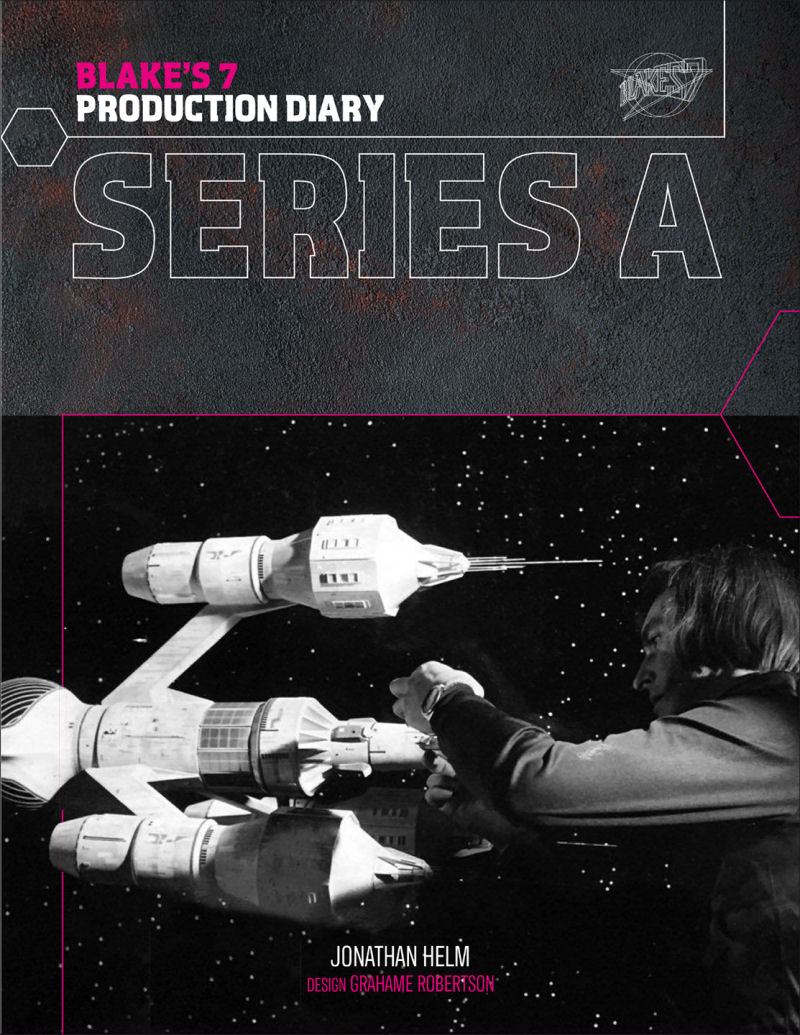Story: The early history of Terry Nation’s legendary dystopian British space opera Blake’s 7 is traced from the initial pitch meeting through the broadcast of the final episode of its first season in down-to-the-day detail, exhaustively researched from the BBC’s archives and accompanied by internal memos, relevant quotes from the cast and crew, and an overabundance of photos.
Review: Cult Edge – a fannish design duo consisting of Grahame Robertson and Carol Ramsay – has been taking a decisive lead in recent years, making up for the lack of published material centered on the late ’70s/early ’80s BBC space opera Blake’s 7. So far Cult Edge has published two short story compilations and two lovingly-illustrated hardback “annuals”, paying homage to the World Publishing kids’ annuals published during the show’s run and expanding on the scope of what would have been published on those annuals considerably. All of these are nonprofit ventures, benefiting various humanitarian charities. I’ll get around to reviewing all of these in due time, but I had a lot of thoughts after absorbing this book.
The Blake’s 7 Production Diary started out as a series of Twitter posts exhaustively researched and written by Helm, and timed to post automatically in a specific order on the corresponding dates, including photos and documentation where relevant. It was an amazing resource. And that account was torpedoed after Twitter became a staggeringly expensive monument to the hubris of an insecure man-child scarcely worth mentioning here, other than that he’d find himself right at home in the pantheon of Blake’s 7’s dystopian villains. So those timed, date-specific morsels of trivia and their accompanying visual documentation – scanned memos, photos, blueprints, and so on – became this book, with Robertson’s usual well-judged print design lending a unified design to all of the material Helm had gathered and written.
The good news is that it might actually find an audience in print that it didn’t find in social media – or, at the very least, a different audience (perhaps including people who weren’t on Twitter in the first place). And a lot of this stuff had never seen print before. That’s the good news. But there are downsides.
Throughout the text, snippets of past interviews with various members of the cast and crew are included, in fairly close proximity to the events described in the text. Some of the quotes are quite recognizable – but there’s no bibliography, which is the kind of thing that’d get a college research paper kicked back to you for revisions, if not summarily graded down as a result. An equal or even greater sin is the omission of any kind of index. A reference work, which this clearly is, should have an index. And as most reference works are built on a combination of original and prior research, a bibliography is, at the very least, a professional courtesy as well.
And space for these things could have been carved out if the text had more prominence than the vast number of pictures here. The issue isn’t with the lovingly reproduced production and publicity stills, or the marvelous happy snaps of sets, models, and props taken by their builders. But there are an awful lot of “filmstrips” consisting of screen grabs, often illustrating specific events being discussed by the text…which, on some pages, seems like it’s crammed into the margins to make room for the photos. It’s the one weakness of the layout of the book that really stuck with me (and usually Cult Edge’s publications are a feast for the eyes and an impeccable testament to long-standing print layout best practices). I was far more interested in the researched text than I was in tiny, postage-stamp-sized screen grabs.
The sheer amount of photography also makes this is a large-format coffee table book with a prohibitive price point (which I gritted my teeth and justified to myself in terms of the money going to good causes). I’m eager to see the other volumes in this series, but I’m hoping for a more balanced layout that favors the text, and perhaps, as a result, a price point that doesn’t feel quite so much like a bunch of screeching Decimas stomping on my wallet.
This is because the text, some of which is expanded considerably from its original Twitter posts, is lovely, painting a very detailed picture of the behind-the-scenes machinations of getting Blake’s 7 on the air and then trying desperately to keep it there. Some of the most tantalizing trivia is the could-have-beens – Martin Jarvis or Maurice Colbourne as Blake? Jane Asher as Cally? Brian Croucher as Vila? Also amazing is the BBC’s insistence on shooting itself in the foot by demanding that the show’s makers seek co-production money from outside the BBC, and then torpedoing the offers they did receive (from Time-Life Pictures in the U.S., which wanted a lock on worldwide rights, or from Mark Shermeldine of London Pictures, future producer of the 1980s Twilight Zone revival), leaving the show with a per-episode special effects budget of £50, befitting the cop show that Blake’s 7 replaced on the schedule. These and so many other details add up to the picture of a show that got made almost in spite of itself.
All of this information deserves a better layout, and it’s so close here, except for those pages where the text is squeezed into narrow columns. After the previous Cult Edge volumes, I was startled to find the layout to be the weak point. I love it, but I just expected to love it more than I did.
This book is available from Lulu.com.
Year: 2023
Author: Jonathan Helm
Publisher: Cult Edge
Pages: 274



